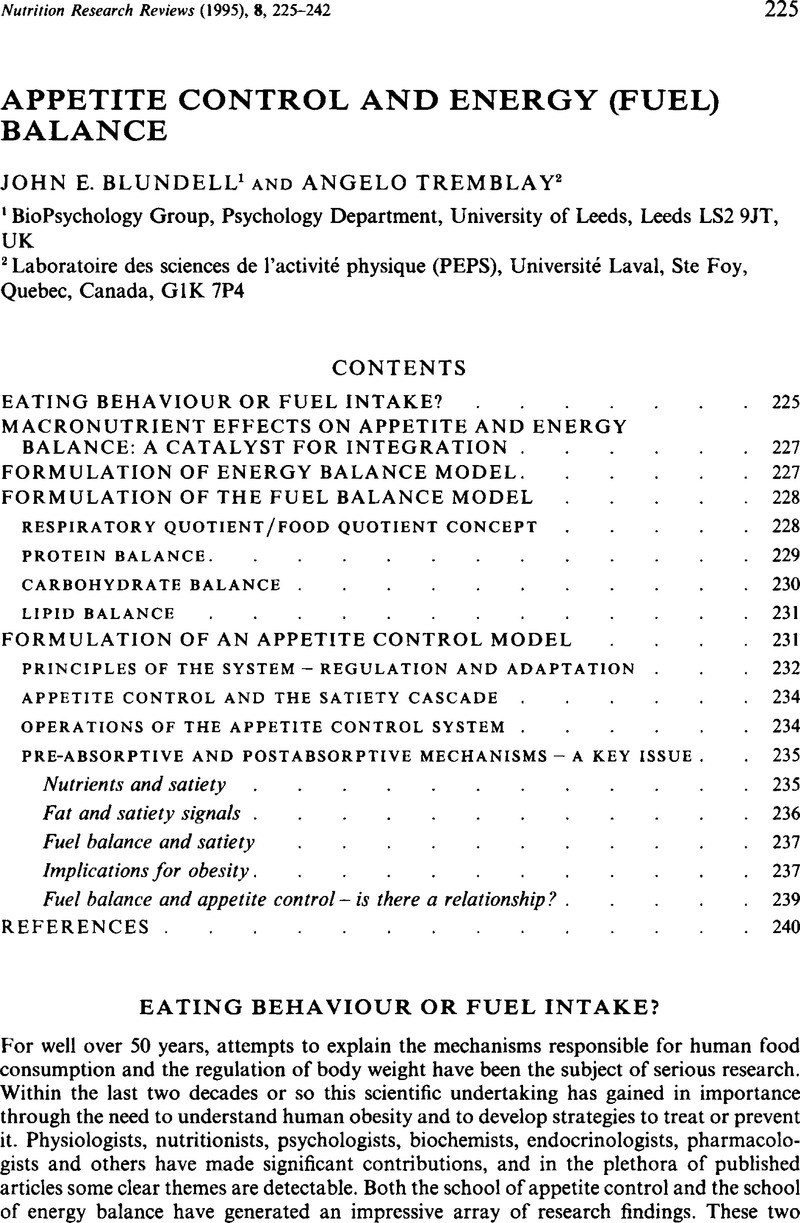Crossref Citations
This article has been cited by the following publications. This list is generated based on data provided by Crossref.
BLUNDELL, JOHN E.
and
MACDIARMID, JENNIE I.
1997.
Passive Overconsumption Fat Intake and Short‐Term Energy Balancea.
Annals of the New York Academy of Sciences,
Vol. 827,
Issue. 1,
p.
392.
BLUNDELL, JOHN E.
and
MACDIARMID, JENNIE I.
1997.
Fat as a Risk Factor for Overconsumption.
Journal of the American Dietetic Association,
Vol. 97,
Issue. 7,
p.
S63.
1997.
Abstracts of Communications.
Proceedings of the Nutrition Society,
Vol. 56,
Issue. 3,
p.
281A.
Oppert, Jean‐Michel
Lahlou, Najiba
Laferrère, Blandine
Roger, Marc
Basdevant, Arnaud
and
Guy‐Grand, Bernard
1997.
Plasma Leptin and Acute Serotoninergic Stimulation of the Corticotropic Axis in Women Who Are Normal Weight or Obese.
Obesity Research,
Vol. 5,
Issue. 5,
p.
410.
SMITH, BRENDA K.
KELLY, LISA A.
PIÑA, RICARDO
YORK, DAVID A.
and
BRAY, GEORGE A.
1998.
Preferential Fat Intake Increases Adiposity but not Body Weight in Sprague-Dawley Rats.
Appetite,
Vol. 31,
Issue. 2,
p.
127.
Lang, V
Bellisle, F
Oppert, JM
Craplet, C
Bornet, FR
Slama, G
and
Guy-Grand, B
1998.
Satiating effect of proteins in healthy subjects: a comparison of egg albumin, casein, gelatin, soy protein, pea protein, and wheat gluten.
The American Journal of Clinical Nutrition,
Vol. 67,
Issue. 6,
p.
1197.
Spyrou, N. M.
1999.
Neutron activation analysis challenges: Problems and applications in biomedical and other areas.
Journal of Radioanalytical and Nuclear Chemistry,
Vol. 239,
Issue. 1,
p.
59.
Stubbs, R.James
1999.
Peripheral signals affecting food intake.
Nutrition,
Vol. 15,
Issue. 7-8,
p.
614.
Livingstone, M. Barbara E.
Robson, Paula J.
Welch, Robert W.
Burns, Amy A.
Burrows, Martin S.
and
McCormack, Caroline
2000.
Methodological issues in the assessment of satiety.
Näringsforskning,
Vol. 44,
Issue. 1,
p.
98.
Groscolas, R.
Decrock, F.
Thil, M.-A.
Fayolle, C.
Boissery, C.
and
Robin, J.-P.
2000.
Refeeding signal in fasting-incubating king penguins: changes in behavior and egg temperature.
American Journal of Physiology-Regulatory, Integrative and Comparative Physiology,
Vol. 279,
Issue. 6,
p.
R2104.
BANNERMAN, E.
DAVIDSON, I.
CONWAY, C.
CULLEY, D.
ALDHOUS, M.C.
and
GHOSH, S.
2001.
Altered subjective appetite parameters in Crohn's disease patients.
Clinical Nutrition,
Vol. 20,
Issue. 5,
p.
399.
French, Stephen J.
and
Yeomans, Martin R.
2001.
Role of the upper gastrointestinal tract in regulation of human feeding.
Nutrition,
Vol. 17,
Issue. 3,
p.
264.
Yeomans, MR
Lee, MD
Gray, RW
and
French, SJ
2001.
Effects of test-meal palatability on compensatory eating following disguised fat and carbohydrate preloads.
International Journal of Obesity,
Vol. 25,
Issue. 8,
p.
1215.
Gray, Richard W.
French, Stephen J.
Robinson, Tristan M.
and
Yeomans, Martin R.
2003.
Increasing Preload Volume with Water Reduces Rated Appetite But Not Food Intake in Healthy Men Even with Minimum Delay Between Preload and Test Meal.
Nutritional Neuroscience,
Vol. 6,
Issue. 1,
p.
29.
Linné, Y
Dye, L
Barkeling, B
and
Rössner, S
2003.
Weight development over time in parous women—The SPAWN study—15 years follow-up.
International Journal of Obesity,
Vol. 27,
Issue. 12,
p.
1516.
Rolland-Cachera, M F
Thibault, H
Souberbielle, J C
Soulié, D
Carbonel, P
Deheeger, M
Roinsol, D
Longueville, E
Bellisle, F
and
Serog, P
2004.
Massive obesity in adolescents: dietary interventions and behaviours associated with weight regain at 2 y follow-up.
International Journal of Obesity,
Vol. 28,
Issue. 4,
p.
514.
Gasbarrini, Antonio
and
Piscaglia, Anna Chiara
2005.
A Natural Diet Versus Modern Western Diets? A New Approach to Prevent ?Well-Being Syndromes?.
Digestive Diseases and Sciences,
Vol. 50,
Issue. 1,
p.
1.
Logan, C.M.
Wallace, J.M.W.
Robson, P.J.
and
Livingstone, M.B.E.
2006.
Improving the Fat Content of Foods.
p.
391.
Logan, C M
McCaffrey, T A
Wallace, J M W
Robson, P J
Welch, R W
Dunne, A
and
Livingstone, M B E
2006.
Investigation of the medium-term effects of Olibra™ fat emulsion on food intake in non-obese subjects.
European Journal of Clinical Nutrition,
Vol. 60,
Issue. 9,
p.
1081.
Yeomans, M.R.
2007.
Consumer-Led Food Product Development.
p.
81.



